
copyright © Wartime Heritage Association
Website hosting courtesy of Register.com - a web.com company
Wartime Heritage
ASSOCIATION
Remembering Earle R. Miller
A 7-Day Pass to London
The picture and copies of the original letter were provided by
David R. Hahn, the grandson of Earle Russell Miller.

Earle Russell Miller (Service No. 283361) enlisted at the age of 17 with the 219th
Battalion at Yarmouth, Nova Scotia, April 3, 1916.
He was born July 4, 1898, in Yarmouth, the son of Avard Herbert and Hannah Sarah
(Allen) Miller.
The following is his account of his 7-day pass (on leave) to London.
The twenty-four page letter, written home, provides a detailed account of his time in
London, England during the First World War between the 3rd and the 9th of November,
1916.




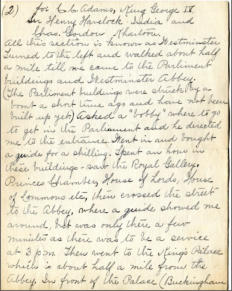

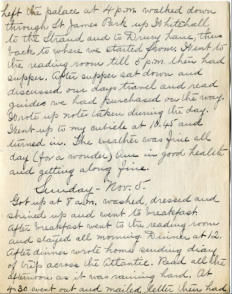

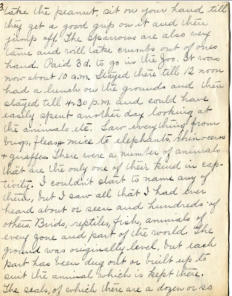




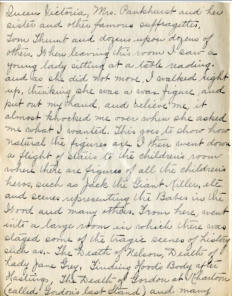



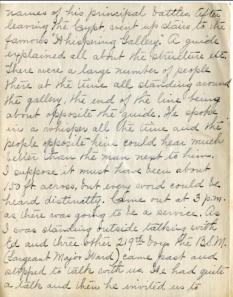

Friday, Nov. 3rd 1916
Reveille
at
6.30
a.m.
Breakfast
at
7
a.m.
During
the
morning
the
battalion
paraded
and
each
man
gave
the
officers
3
shillings
to
buy
tickets.
Prepared
to
go
on
pass
the
rest
of
the
morning.
Dinner
at
12
noon.
At
2
p.m.
paraded
to
the
M.
O.
and
he
gave
each
man
a
slip
with
names
of
some
of
the
hospitals
in
London,
so
if
taken
sick
while
there
one
would
know
where
to
go.
Paraded
again
and
got
our
tickets.
At
3
p.m.
left
Witley
Camp
for
Milford,
the
nearest
railway
station,
where
we
boarded
the
train
for
London.
Arrived
at
Waterloo
Station,
London
at
5.30
p.m.
From
there
walked
about
1/2
mile
till
I
came
to
the
Strand,
asked
a
“Bobby”
where
to
go
and
he
directed
me
to
the
Bruce
House
on
Drury
Lane.
Had
a
good
supper,
after
which
I
went
for
a
walk
but
as
it
was
raining
hard
could
not
see
very
much.
Almost
got
run
down
a
number
of
times
at
street
corners,
before
I
found
out
about
how
the
taxis
and
auto
run.
London
is
very
dark
at
night.
All
the
lights
are
shaded
as
that
there
is
about
a
circle
of
radius
2
ft.
that
is
lit
up.
I
almost
got
lost,
as
there
are
so
many
streets
and
they
cross
in
a
very
bewildering
manner.
They
never
seem
to
cross
at
right
angles,
but
always
at
a
small
angle
so
that
one
does
not
know
which
one
to
take,
but
found
my
way
back
safely
about
9
p.m.
Sat
down
in
the
reading
room
and
read
until
10.30
and
then
went
to
bed.
I
have
a
separate
cubicle to sleep in. The beds are clean and so I am comfortable. Am in good
health. It has rained nearly all day.
Saturday - Nov. 4.
Got
up
at
7.15
a.m.
Cleaned
up,
had
a
wash
and
went
to
breakfast
at
8.30.
After
breakfast
checked
greatcoat,
haversack,
bought
ticket
for
next
night,
then
started
out
with
Ed
to
have
a
look
around.
We
thought
we
would
go
to
the
“Tower”
first.
Walked
down
Drury
Lane
till
we
came
to
the
Strand.
Met
a
postman
and
inquired
the
way
to
the
“Tower”.
He
at
once
told
us
he
would
show
us
the
way.
(The
English
people
are
very
obliging
to
the
Canadian
soldiers
-
they
will
do
almost
anything
for
them.)
He
led
us
down
to
the
Victoria
Embankment
and
then
to
Temple
Station
(an
underground
railway
station.)
We
bought
tickets
for
Mark
Lane
and
boarded
the
train
(a
string
of
a
dozen
or
so
electric
cars.)
Got
off
at
Mark
Lane
and
went
up
stairs
and
emerged
about
150
yds
from
the
Tower.
About
10
a.m.
when
we
reached
the
Tower.
The
postman
left
us
here
and
would
not
take
a
penny
for
showing
us
the
way.
Spent
all
the
morning
exploring
the
Tower
and
the
only
thing
I
wished
during
that
2
hours
was
that
I
could
remember
a
little
more
history.
The
men
who
take
care
of
the
place
and
act
as
guides
are
yoeman
[sic]
dressed
in
the
old
fashioned
uniforms
of
which
I
have
often
seen
pictures.
I
never
spent
a
better
or
more
interesting
2
hours
in
my
life
and
never
expect
to.
Took
note
while
there
and
was
given
a
guide
which
explained
all
about
the
place.
I
went
to
every
place
and
saw
even
more
than
is
told
in
the
guide.
Saw
bloody
tower,
crown
jewels,
Raleigh’s
walk,
dungeons,
Beauchamp
tower,
site
of
execution
scaffold.
After
dinner
walked
down
the
Strand
to
Trafalgar
Square.
Saw
Nelson
monument
(sculptured
by
I.E.
Crew
Copenhagen
in
1801)
There
are
a
number
of
monuments
near.
They
are
for
G.C.
Adams,
King
George
IV,
Sir
Henry
Havelock
-
India
and
Chas.
Gordon
Khartoum.
All
this
section
is
known
as
Westminster.
Turned
to
the
left
and
walked
about
half
a
mile
till
we
came
to
the
Parliament
buildings
and
Westminster
Abbey.
(The
Parliament
buildings
were
struck
by
a
bomb
a
short
time
ago
and
have
not
been
built
up
yet.)
Asked
a
“bobby”
where
to
go
to
get
in
the
Parliament
and
he
directed
me
to
the
entrance.
Went
in
and
bought
a
guide
for
a
shilling.
Spent
an
hour
in
these
buildings
-
saw
the
Royal
Gallery.
Princes
Chamber,
House
of
Lords,
House
of
Commons
etc,
then
crossed
the
street
to
the
Abbey,
where
a
guide
showed
me
around,
but
was
only
there
a
few
minutes
as
there
was
to
be
a
service
at
3
p.m.
Then
went
to
the
King’s
Palace
which
is
about
half
a
mile
from
the
Abbey.
In
front
of
the
Palace
(Buckingham
Palace)
is
the
Queen
Victoria
Memorial.
It
is
made
of
white
marble
except
where
sightseers
walk,
and
there
it
is
brown
granite.
The
figure
on
top
is
some
kind
of
gilt,
and
the
statues
at
the
entrance
are
of
black
material.
At
the
entrance
farthest
from
the
palace
are
two
statues.
One
of
a
man
with
his
hand
on
a
lion
and
the
other
of
a
woman
with
her
hand
on
a
lion.
The
woman
holds
a
branch
in
her
free
hand
and
the
man
a
torch.
Nearest
the
palace
are
two
more
statues
of
a
man
and
woman
each
with
their
hand
on
a
lion.
The
man
is
a
black-
smith
with
his
hammer
in
his
free
hand
the
woman
has
a
scythe
in
her
hand.
Written
on
the
monument
on
the
side
away
from
the
palace
are
these
words
-
(Victoria Regina Imperatrix) and on the opposite side MDCCCXXXVII MDCCCCI.
Left
the
palace
at
4
p.m.
walked
down
through
St.
James
Park
up
Whitehall
to
the
Strand
and
to
Drury
Lane,
thus
back
to
where
we
started
from.
Went
to
the
reading
room
till
5
p.m.
then
had
supper.
After
supper
sat
down
and
discussed
our
days
travel
and
read
guides
we
had
purchased
on
the
way.
Wrote
up
notes
taken
during
the
day.
Went
up
to
my
cubicle
at
10.45
and
turned
in.
The
weather
was
fine
all
day
(for
a
wonder)
Are
in
good
health
and
getting
along
fine.
Sunday - Nov. 5.
Got
up
at
8
a.m.
washed,
dressed
and
shined
up
and
went
to
breakfast.
After
breakfast
went
to
the
reading
room
and
stayed
all
morning.
Dinner
at
12.
After
dinner
wrote
home
sending
diary
of
trip
across
the
Atlantic.
Read
all
the
afternoon
as
it
was
raining
hard.
At
4.30
went
out
and
mailed
letter
then
had
supper.
After
supper
went
to
a
movie
show
for
which
I
paid
1
shilling.
After
the
show
walked
around
for
a
while
then
met
Ed*
and
some
more
of
the
boys
and
walked
around
and
had
some
fun.
Returned
to
the
Bruce
House
at
11.30
p.m.
and
turned
in.
Not
a
very
interesting
day
on
account
of
the
rain,
but
it
cleared
off after supper.
Monday - Nov. 6.
Turned
out
at
8.30
and
had
breakfast.
Then
started
out.
Decided
to
go
to
the
Zoo.
Went
to
Trafalgar
Sq.
and
took
the
underground
for
Regents
Park.
Got
off
on
inquired
of
a
“bobby”
where
to
go.
Walked
through
the
park
for
about
5
minutes
and
then
came
to
the
Zoo.
Bought
some
peanuts
to
feed
the
squirells
[sic]
and
monkeys.
Had
some
fun
feeding
the
squirrels
before
going
in
the
Zoo.
They
are
American
grey
squirrels
and
very
tame.
They
jump
up
on
your
shoulder,
run
down
your
arm,
take
the
peanut,
sit
on
your
hand
till
they
get
a
good
grip
on
it
and
then
jump
off.
The
sparrows
are
also
very
tame
and
will
take
crumbs
out
of
ones
hand.
Paid
3
d.
to
go
in
the
Zoo.
It
was
now
about
10
a.m.
Stayed
there
till
12
noon
had
lunch
on
the
grounds
and
then
stayed
till
4.30
p.m.
and
could
have
easily
spent
another
day
looking
at
the
animals
etc.
Saw
everything
from
bugs,
fleas,
&
mice
to
elephants,
rhinoceros
&
giraffes.
There
were
a
number
of
animals
that
are
the
only
one
of
their
kind
in
captivity.
I
couldn’t
start
to
name
any
of
them,
but
I
saw
all
that
I
had
ever
heard
about
or
seen
and
hundreds
of
others.
Birds,
reptiles,
fish,
animals
of
every
zone
and
part
of
the
world.
The
ground
was
originally
level,
but
each
part
had
been
dug
out
or
built
up
to
suit
the
animal
which
is
kept
there.
The
seals,
of
which
there
are
a
dozen
or
so
have
a
large
deep
pool
all
built
up
on
two
sides
with
concrete
to
represent
blocks
of
ice.
The
goats
have
a
regular
mountain
to
run
about,
rugged
just
as
they
have
been
used
to.
The
lions
have
caves
in
the
rocks
for
dens.
The
storks
have
a
small
river
to
wade
in.
The
monkeys
miniature
trees,
the
rhinoceros
large
pools,
and
each
one
has
just
what
he
has
been
used
to
before
his
captivity.
It
was
certainly
great
and
I
had
a
fine
time.
Started
for
Bruce
House
at
4.30
p.m.
Had
supper
and
then
went
out
to
have
some
fun.
Walked
down
to
Trafalgar
Sq.
and
was
standing
there
when
a
fellow
came
walking
across
with
a
drunken
fellow.
The
drunk
fell
in
the
middle
of
the
street,
and
the
other
one,
who
had
only
been
out
of
the
hospital
three
days
could
not
get
him
up.
I
went
and
helped
him
and
then
spent
most
of
the
evening
getting
the
drunk
to
his
boarding
place
which
was
on
Sussex
St.
off
Piccadilly
Both
fellows
were
South
Africans.
The
one
just
out
of
hospital
told
me
all
about
himself
and
his
battalion.
Their
brigade
left
South
Africa
5000
strong
of
which
there
are
243
left.
He
himself
came
out
of
the
trenches
Sept.
28.
sick
with
trench
fever
and
had
been
in
the
hospital
ever
since.
He
told
me
about
the
fever.
it
is
something
like
Influenza
only
10
times
as
bad.
I
walked
around
with
him
until
10.30
then
went
to
back
to
turn
in,
but
as
I
was
getting
ready
to
turn
in,
in
came
two
fellows
-
one
a
Highlander
from
Winnipeg
(49th
Bat)
the
other
an
Australian.
They
had
just
come
from
the
trenches
for
10
days
leave.
I
stayed
and
talked
with
them
about
the
trenches
until
2
a.m.
and
certainly
was
interesting.
They
had
both
been
thro
the
fighting
at
the
Somme.
The
Highlander
was
the
most
interesting
as
he
had
a
good
education
and
was
a
fine
talker.
He
showed
me
maps
of
the
Somme
and
told
me
all
about
the
fighting
conditions
at
the
front,
how
the
men
are
used,
etc,
and
as
he
has
been
to
the
front
for
19
month
he
ought
to
know
something
about
it.
The
battalion
that
the
Australian
was
in
was
all
cut
to
pieces,
there
being
only
13
fit
men
left
-
all
the
rest
either
killed or wounded.
Turned in about 2.30 a.m.
Still in fine health - weather fine.
Tuesday - Nov. 7
Turned
out
about
9
a.m.
Decided
to
go
to
Madame
Tresseau’s
[sic]
Wax
Works.
Walked
to
Trafalgar
Sq.
and
took
the
underground
to
Bake
St.
Station
which
is
within
about
50
yds.
of
the
works.
Paid
1
s.
2
d.
to
enter
-
the
2
d.
being
amusement
tax.
Walked
up
a
flight
of
stairs,
saw
a
policeman
standing
at
the
door,
and
not
thinking
where
I
was
I
went
up
to
him
and
asked
him
which
direction
to
go
in
and
got
no
answer.
I
certainly
felt
foolish
when
I
found
that
he
was
only
a
wax
figure.
But
I
was
not
the
only
one
to
be
fooled,
as
a
good
many
of
the
boys
did
the
same
thing.
The
first
room
is
called
the
Grand
Hall
and
in
it
are
figures
of
all
the
English
rulers
from
William
I
to
George
V,
and
they
were
so
real
that
I
could
almost
see
them
move
sometimes.
I
could
almost
swear
sometimes
that
I
saw
their
eyelids
move.
From
the
Grand
Hall,
went
into
the
next
room
where
there
were
figures
of
all
the
principal
men
of
the
present
and
past.
General
French,
Lord
Kitchener,
the
principal
members
of
the
present
parliament,
Duke
Nicholas,
Joffre,
Foch,
Jellico,
and
all
the
other
war
heros.
John
Cornwall
[sic]
[Cornwell]
V.C.
and
also
a
couple
more
V.C’s,
the
Queen,
Queen
Victoria,
Mrs.
Pankhurst
and
her
sister
and
other
famous
suffragettes,
Tom
Thumb
and
dozens
upon
dons
of
others.
When
leaving
this
room
I
saw
a
young
lady
sitting
at
a
table
reading,
and
as
she
did
not
move,
I
walked
right
up,
thinking
she
was
a
wax
figure,
and
put
out
my
hand,
and
believe
me,
it
almost
knocked
me
over
when
she
asked
me
what
I
wanted.
This
goes
to
show
how
natural
the
figures
are.
I
then
went
down
a
flight
of
stairs
to
the
children’s
room
where
there
are
figures
of
all
the
children’s
heros,
such
as
Jack
the
Giant
Killer,
etc.
and
scenes
representing
the
Babes
in
the
Wood
and
many
others.
From
here,
went
into
a
large
room
in
which
there
was
staged
some
of
the
tragic
scenes
of
history,
such
as,
-
The
Death
of
Nelson,
Death
of
Lady
Jane
Grey,
Finding
Hood’s
Body
after
Hastings,
The
Death
of
Gordon
at
Khartoum
(called
Gordon’s
last
Stand)
and
many
others
of
a
similar
kind.
These
are
all
life
size
and
are
staged
just
as
they
happened.
There
is
a
small
chart
near
each
one
giving the names of the characters.
Went
back
up
stairs
and
paid
6d.
to
see
the
“Chamber
of
Horrors”.
Just
before
going
into
the
chamber
there
is
a
small
room
given
over
wholly
to
relics
of
Napoleon.
In
it
are
his
state
carriage
-
the
carriage
in
which
he
rode
from
Waterloo.
A
piece
of
the
tail
of
Marengo
(Napoleon’s
favorite
horse
which
he
rode
at
Waterloo,
a
walking
stick
of
Napoleon’s,
his
rings,
teeth,
lock
of
his
hair,
pieces
of
his
coffin,
earth
from
his
grave,
a
piece
of
the
tree
under
which
he
was
buried
and
hundreds
of
other
things.
There
was
also
in
this
apartment
the
coat
Nelson
wore
when
he
received
his
mortal
wound,
the
bullet
hole
is
shown.
From
here
went
to
the
“Chamber
of
Horrors”
where
there
are
to
be
seen
all
the
noted
murderers
and
noted
men
that
have
been
executed
and
scenes
representing
some
of
the
murders.
Among
the
figures
is
that
of
Roger
Caseman
[sic]
[Casement],
all
of
the
leaders
of
the
French
Revelution
[sic]
who
were
guillotined.
All
the
principal
instruments
of
torture,
and
a
regular
sized
guillotine
with
the
figure
of
a
man
with
his
head
on
the
block
to
show
his
position
and
the
way
it
works.
Heads
of
the
French
revelutionists
[sic]
just
as
they
looked
after
being
guillotined
with
blood
all
over
their
features.
After
leaving
this
room,
went
into
a
small
room
where
there
were
some
of
those
curved
mirrors
which
makes
a
person
look
so
funny.
I
suppose
these
were
to
make
one
forget
the
gruesome
sights
in
the
Chamber
of
Horrors.
One
[sic]
[On]
the
way
out
I
noticed
a
figure
of
Edith
Carvell
[sic]
[Cavell].
When
I
got
outside
it was 12.30. Went back to the house and had dinner and then decided to go to
St. Paul’s Cathedral.
Walked
down
to
Victoria
Embankment
and
thence
to
the
Cathedral
-
about
25
minutes
walk.
First
went
all
around
the
main
part
of
the
church
looking
at
the
statues
and
memorials.
A
guide
explained
to
me
who
built
the
cathedral
when
destroyed,
who
did
all
the
carving
etc.
but
it
was
too
much
to
go
into
my
head
at
one
time
and
I
forgot
it
all.
I
then
went
down
stairs
into
the
Crypt.
The
majority
of
people
buried
there
were
military
or
naval
heros.
The
most
noted
are
Wellington
&
Nelson.
Wellington
has
two
monuments
there.
Both
are
about
14
x
10
at
the
base
-
one
much
higher
than
the
other.
There
is
also
kept
in
this
place
his
funeral
carriage.
It
is
a
huge
object
supported
by
six
wheels
3
on
each
side.
It
is
made
of
bronze
and
at
a
cost
of
£20,000.
On
it
are
the
standards
of
Wellington’s
own
regiments
and
around
the
sides
are
engraved
the
names
of
his
principal
battles.
After
leaving
the
Crypt,
went
up
stairs
to
the
famous
“Whispering
Gallery”.
A
guide
explained
all
about
the
structure
etc.
There
were
a
large
number
of
people
there
at
the
time
all
standing
around
the
gallery,
the
end
of
the
line
being
about
opposite
the
guide.
He
spoke
in
a
whisper
all
the
time
and
the
people
opposite
him
could
hear
much
better
than
the
mean
next
to
him.
I
suppose
it
must
have
been
about
150
ft.
across,
but
every
sound
could
be
heard
distinctly.
Came
out
at
3
p.m.
as
there
was
going
to
be
a
service.
As
I
was
standing
outside
talking
with
Ed*
and
three
other
219th
boys
the
B.S.M.
(Sergeant
Major
Ward)
came
past
and
stopped
to
talk
with
us.
He
had
quite
a
talk
and
then
he
invited
us
to
supper.
He
took
us
to
a
restaurant
and
gave
us
a
swell
feed
and
then
left
us.
We
walked
around
for
a
time
and
then
decided
to
go
to
a
good
theatre.
Met
a
Canadian
who
was
living
in
London
and
he
advised
is
to
go
to
“His
Majesty”
to
see
“Chin
Chin
Chow”.
Well
we
went
and
it
certainly
was
a
fine
play.
The
scenery
alone
cost
£50.000
and
there
were
some
of
the
best
actors
in
London
in
the
play.
The
music
was
something
wonderful,
I
could
feel
myself
rising
right
out
of
my
seat
about
half
of
the
time.
The
play
started
at
7.30
p.m.
and
finished
at
11.15
but
it
didn’t
seem
to
be
much
more
than
an
hour. After the play went home and turned in at 11.45 p.m.
In fine health. - fine during morning but clouds afternoon and evening.
Wednesday - Nov. 8.
Turned
out
at
8.30
and
went
to
breakfast.
After
breakfast
walked
down
to
Westminster
Bridge
and
stood
there
all
the
morning
watching
the
water
craft
and
the
traffic
across
the
bridge.
There
is
a
fine
view
of
the
Parliament
Buildings
from
this
place.
Most
of
the
pictures
of
the
buildings
are
taken
from
the
bridge.
Went
back
to
the
house
for
dinner
at
12
noon.
After
dinner
went
down
to
Whitehead
one
of
the
best
museums
(the
Royal
United
Service)
bought
a
guide
at
the
door.
Spent
all
afternoon
examining
the
relics
and
models
kept
there.
They
are
too
numerous
to
start
to
mention.
One
thing
that
I
took
great
interest
in
was
a
model
of
the
Battle
of
Waterloo.
The
model
covers
an
area
of
400
sq.
ft.
and
is
made
to
scale
every
hill
and
valley
being
represented.
The
armies
are
represented
by
small
figures
and
the
ground
is
covered
with
the
wounded
and
dead.
The
armies
are
in
the
position
they
were
just
after
the
defeat
of
Napoleon’s
“Old
Guard”.
There
were
many
other
models
of
a
similar
kind,
also
models
of
battleships,
dreadnoughts,
battle
cruisers,
cruisers,
destroyers
etc.,
and
a
regular
sized
torpedo.
There
was
a
model
of
the
battle
cruiser
H.M.S.
Queen
Mary
-
about
15
ft.
long.
Left
the
museum
and
went
to
supper.
After
supper
went
to
the
Hippodrome
to
see
“Flying
Colors”.
This
was
a
fine
show
but
not
as
good
as
“Chin
Chin
Chow”.
Went
to
the
house
and
turned
in at 11.45 p.m. Fine weather all day.
Are in fine health.
Thursday Nov. 9
Turned
out
at
9
a.m.
and
then
had
to
be
pulled
out
as
we
were
all
supposed
to
be
down
stairs
at
9.
Had
breakfast
and
then
walked
down
the
Strand
to
Trafalgar
Sq.
where
I
met
Geo.
Wagner**
and
about
a
couple
of
dozen
of
the
boys.
We
stayed
there
till
noon
playing
around
and
making
fools
of
ourselves
generally.
It
was
a
holiday
as
there
was
to
be
a
procession
in
which
Lord
Mayor
was
to
be.
The
procession
was
to
go
past
Trafalgar
Sq.
at
3.30
p.m.
but
the
crowd
started
to
gather
at
noon
so
we
all
stayed
where
we
were
till
the
procession
came
past.
I
thought
I
had
seen
crowds
before
,
but
they
were
just
small
groups
compared
with
the
crowd
that
gathered
to
see
that
procession.
It
was
formed
up
of
Canadians,
Australians,
New
Zealanders,
South
Africans,
British
Troops,
Flying
Corps,
Scots
Guards,
Grenadier
Guards,
Coldstream
Guards
,
Cadets,
Boy
Scouts,
Captured
German
aeroplane,
three
captured
German
guns
etc.
After
the
procession
passed
I
stood
talking
to
a
wounded
soldier
for
a
while
and
then
started
back
but
could
not
move
along
the
Strand
at
all,
because
of
the
crowd.
Had
to
go
down
to
the
river
and
walk
along
Victoria
Embankment
to
Waterloo
bridge
and
from
there
to
the
house.
Had
to
wait
15
minutes
before
I
could
get
across
the
Strand.
Had
supper
at
4.30
p.m.
then
started
to
get
ready
to
go
back
to
camp.
Started
for
Waterloo
Station
at
5.30,
got
the
6.40
train
for
Godalming
(3
miles
from
camp)
Arrived
at
Godalming
at
7.35.
Waited
for
a
bus
till
9.
Arrived
at
camp
at
8.20
p.m.
but
did
not
go
in
then
as
we
found
that
the
219th
was
quarantined
on
account
of
Spinal
Meningitis,
there
being
5
or
6
cases.
Had
to
go
in
and
report
anyway,
so
went
in
at
9
p.m.
First
thing
to
do
after
handing
in
my
pass
was
to
gargle
my
throat
with
some
kind
of
solution.
Went
to
the hut, made bed and turned in at 9.30 p.m. Are in good health
Has been the best kind of weather all day.
Pte. E. R. Miller No 283361
H 2 Co. 219th Highland Bat.
C. E. F.
Witley Camp.
c/o Army Post Office,
London
Eng.
* Edmund McConnell Lewis (Service No. 283360)
Yarmouth, NS
** George Morris Wagner (Service No. 282660)
Tusket, Yarmouth Co., NS

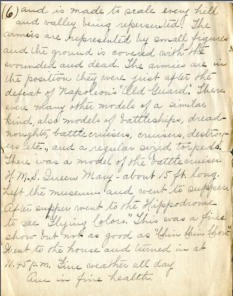

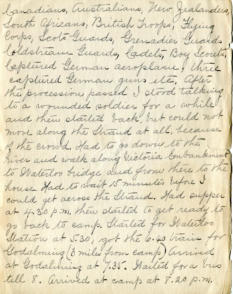
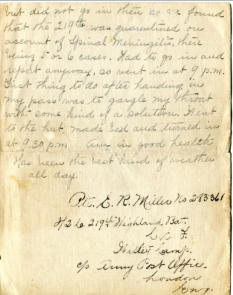


- World War I - Menu
- WWI Stories and Articles
- Photos - Yarmouth Soldiers
- Selection of World War I Songs
- WWI Casualties of Yarmouth, NS
- Those Who Served - Yarmouth, NS
- WWI Casualties Digby Co. NS
- WWI Casualties Shelburne Co. NS
- Merchant Mariners (1915) Yarmouth, NS
- Canadian Forestry Corps - Non Yarmouth Birth/Residence Enlistments
- US Draft Registry - Yarmouth NS Born


- World War II - Menu
- WWII Stories and Articles
- Telegraphist Air Gunners
- WWII Casualties of Nova Scotia
- US Casualties with NS Connection
- Far East/Pacific Casualties with NS Connection
- Merchant Navy Casualties Nova Scotia
- Nova Scotia WWII Casualties Holten Canadian War Cemetery
- D-Day Casualties - Nova Scotia
- CANLOAN Program Casualties - Nova Scotia
- Battle of the Bulge Casualties - Nova Scotia
- WWII Casualties Yarmouth NS
- Yarmouth Casualties - RCAF RAF Canadian Army WWII
- Yarmouth Co., Marriages WWII
- Casualties Non-Born/Residents with Connection to Yarmouth Co., Nova Scotia.
- WWII Casualties Digby Co., NS
- Non-Nova Scotian WWII Casualties Buried in Nova Scotia
- WWII RCAF Casualties Aged 16-18
- Brothers/Sisters Who Served - World War II














